While most collectors have their eyes set on older models from the “Big Three” automakers, there are a lot of great bargains out there from lesser-known companies. While names like Kaiser, Crosley, Studebaker, and Nash have become footnotes in history, many of their products are still around and can still be quite the prize for someone who wants something a little out of the mainstream. This 1948 Nash 600 Brougham deluxe coupe for sale on Craigslist in Mukwonago, Wisconsin is such a vehicle. Believed to have just 35,761 miles, this historically significant Nash is highly original and looks ready to drive home today. Is the asking price of $16,900 reflective of the market value for an off-brand car in such condition? Would you prefer something different for your local cruise in? Thanks to the eagle-eyed reader T.J. for this postwar find!
By the end of the 1930s, the herd of independent carmakers had thinned considerably. The Depression was an incredible stress test on all but the best capitalized and led companies. Add to that the auto industry was one where economies of scale were playing an ever-increasing role in lowering the cost of the vehicles from General Motors, Ford, and Chrysler. That lower cost meant two things. The first was more profit and the second was the ability to lower prices to take market share away from weaker competitors. The independent makers had to counter with innovative products that occupied niches in the market or innovated to the point that they enjoyed an edge until the rest of the industry caught up.
Nash took both routes. The niche in the marketplace they pursued was fuel economy. To achieve better efficiency than their competitors, Nash innovated by introducing what would come to be known as unit body construction. Standard construction dictated a heavy frame with a body mounted to the top. Nash’s approach for the car that came to be known as the 600 was that the stamped and welded-together body provided the rigidity that the vehicle needed to be safe. Introduced in 1941 and outfitted with a small displacement inline-six-cylinder engine and a three-speed transmission with overdrive, the 600 was advertised as able to travel 600 miles on a tank of fuel. This was due mainly to the weight savings of this type of construction.
The 600-mile claim was backed up by the car’s performance in the Mobilgas Economy Run. This contest was sort of a gas mileage race that all of the manufacturers usually took part in. Bear in mind that the entries were about as fresh from the factory as a NASCAR stock car was at the time (read Smokey Yunick’s autobiography for an in-depth account of the shenanigans). In 1941, the 600 won its class with an official number of 25.81 miles per gallon. Even if that number is not entirely similar to those that customers got when they calculated their mileage, the car was noticeably more efficient than similar cars. The unit body construction method was claimed to have saved 500 pounds overall. Add to that the thrifty engine and an overdrive transmission and you can see just how the car filled a niche.
That niche would come to be very valuable when fuel rationing brought on by World War II began in 17 eastern states in May of 1942 and was expanded to the rest of the country by December of that year. Production of civilian automobiles had stopped by that time. However, those lucky enough to have a Nash 600 during the war must have enjoyed maximizing the fuel mileage they got out of their gas rationing card. Especially if they held an “A” card. These allowed the holder to just four gallons of gasoline per week. Add to that the fact that speed limits were enacted to restrict vehicles to 35 miles per hour. Under these conditions, one could see where one of these Nash 600s was a hot commodity on the used car market during that time.
After the war, the 600 was produced until the new “bathtub” Nash automobiles hit the streets in 1949. Marketing for these cars had shifted to promoting the 600 as a more entry-level vehicle. The 1948 Nash 600 you see here is one of the last of the line for these venerable fuel savers. While it may have been marketed as a lower-line model, the pictures reveal a car with numerous options. Among those are two-tone paint, trim rings, bumper guards, an in-dash clock, a radio, and a heater. The cloth upholstery also looks as if it may have been an optional upgrade. Add to that the fact that it was branded a Brougham. This title, often used on Cadillacs later in the century, usually denotes a more luxurious edition of a car.
The seller, who is handling the transaction for an elderly client, claims that 11,530 examples of the 1948 Nash two-door Brougham were built. They furthermore claim that this car has just 35,761 miles on the odometer. A look at the general wear and tear on the interior in general and the car overall back up this claim. While consumable items have been replaced, original is a term that has a broad definition. We are not told if the paint or any of the chrome has been repaired or re-plated. We also don’t have a great picture of the engine compartment. What we can see from the picture below looks like the car has received some restoration work under the hood. We do know by the exhaust smoke shown in one of the pictures in the ad that the car runs.
In all, it looks to be a very nice car that may be quite a prize for someone who fancies an immediate postwar coupe that is not a Ford, Plymouth, or Chevrolet. The $16,900 asking price may be a bit difficult to obtain given the state of the market for cars of this era. It is, however, a very interesting example of a car that brought a new type of construction to market and was one of the first full-size cars to be marketed with fuel efficiency as its major claim. Hopefully, it finds a good home and is shown by someone who can explain its importance.
Would you purchase a collectible car made by one of the independent automakers? Do you think the asking price for this interesting Nash is realistic? Please share your thoughts in the comments.
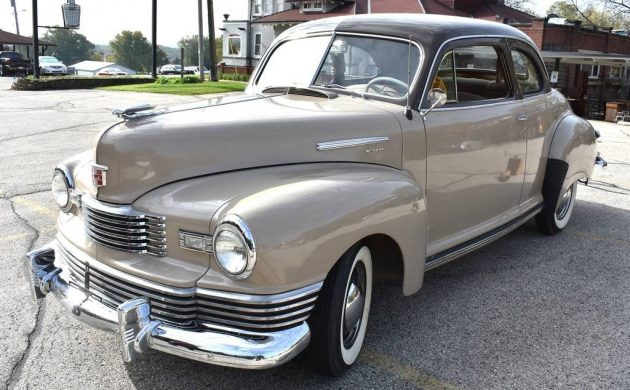

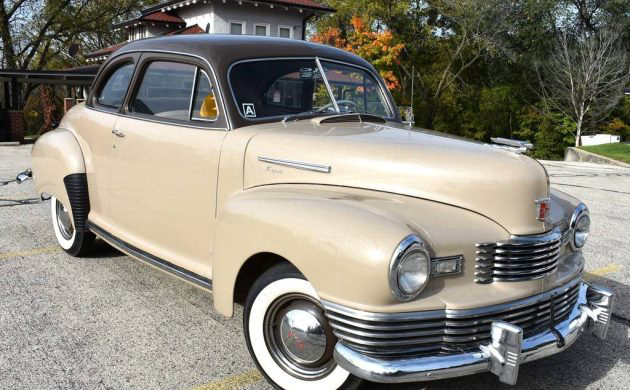
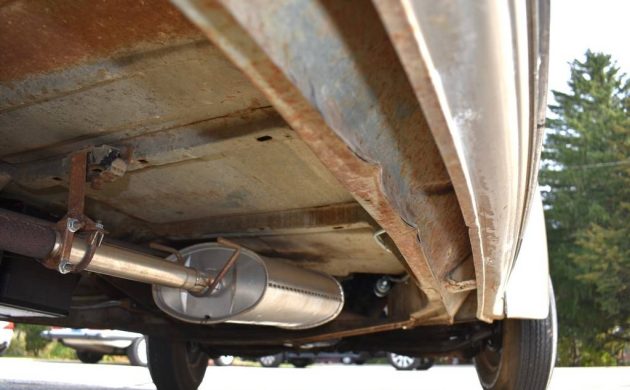

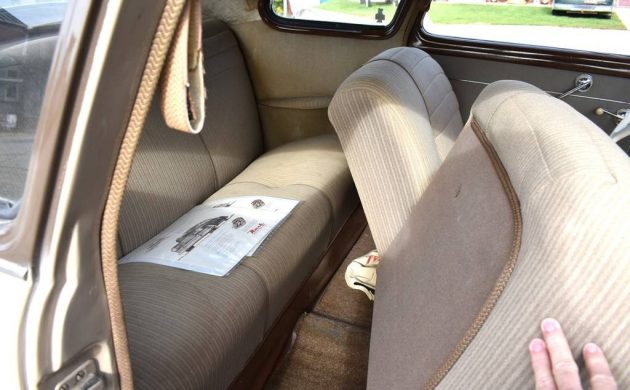
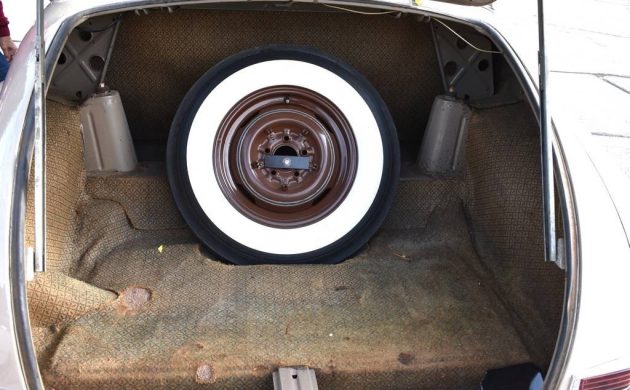
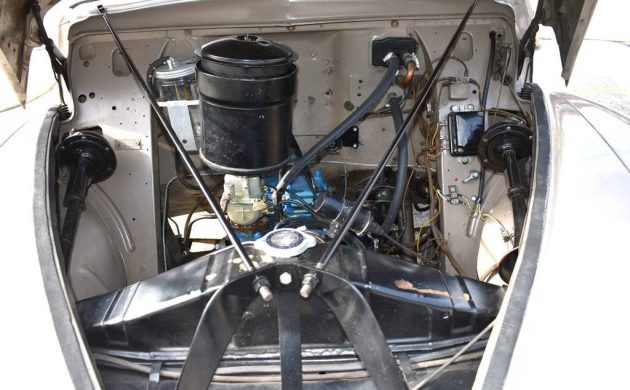







I’m gonna say it’s water vapor and not exhaust smoke. Either way, it’s a really cool old car, and it’s not a Mustang, Corvette, GTO, Camaro, etc. ad nauseum.
Coolant in the engine oil gives off white smoke, could be a cracked block, if the oil is over the full level and discolored, defiantly a cracked block. How do I know? It happened to me.
Coolant in the engine oil gives off white smoke? Wrong. Cracked block. Correct. Coolant getting into the cylinder is what causes the smoke. The glycol in the AF is essentially a fog machine when introduced to the heat of combustion. The two issues are not mutually exclusive.
There was a nearly identical 1942 Nash in our family during the War. My father was overseas, and his ’39 Packard was something my mother would not drive. Her Nash was the same colour (or, close), as this one — but without the contrasting top. The upper section of the grille was somewhat narrower, and that ’42 looked subtly more “art deco”, somehow. The interior was about the same, but hers had neither radio nor clock. It was a reliable car — and the worst problem that occurred (in 1948) was a bad muffler and its resulting “roar”: we joked that we were running an aeroplane, because of the loud noise under the floor in the passenger compartment — until she had it fixed. That muffler difficulty seemed endemic to Nash cars of this era, back when they still were common on the road. The sight of this one instantly takes me back seventy-five and more years. Wish I had the means, and the place, to add it to my life. Given the current market, however, its price seems a bit steep.
That’s a rare one ! Not only is this car rare , but being an original low mileage survivor , makes it valuable . There aren’t many of those left anymore , as most of those old Nashe’s were sent to the scrapyards long ago . Asking price ? I think this 1948 Nash is ” Priced Right !”
I quite agree. Seeing the ad nauseum so often, it’s truly nice to twist my neck when the unusual glides by. My ’50 Commodore has twisted other necks. A neat feeling.
I can just see me driving this to pick up my sister, and her saying, “You’ve got to be KIDDING me.”, as she remembers our days in that ’42. I think our car’s interior was more tan and brown, than this one, and I believe our steering wheel was plainer.
That front end is real close to a Lincoln. Nice coupe, price seems reasonable
Appears to be a nice car. Parents had a 65 Rambler 550 Station wagon. It was a plain car only the burgundy color was nice. Good mechanically but a teen didn’t want to be seen in one. The price may be slightly high.
The 600s were quickly identified from the larger Nashes by their semi-skirted rear wheels.
Nice to see this. My parents had a 48 Nash Ambassador four door much like this. That model used the unibody, plus a frame (i.e., belt and suspenders). My sister and I used to stand in the back seat, holding onto the strap behind the front seat. Probably not the safest, but better than a car seat hung over the front seat back, ready to launch through the windshield.
That Nash is a beautiful car. I was born in 1945 so I saw and liked a lot of cars like this when growing up. If I had the money and storage access I would love to own this car.
Handsome car in every way. Looks attractive even among all the post war models being introduced back then. Love the couple styling.
“couple”?
Yeah, auto correct AI isn’t as smart as it thinks it is. Must learn to proof read before sending. lol
If the car has the reclining front seats that later Nash / Ramblers had then there could be some “couple styling” going on!
Nice! I’m liking this for a number of reasons. Color, style and from what you can discern from the pictures, condition. I’m partial to the cars of this era too. Nash vehicles were well built and smartly engineered. I’d love to have this. But It would be hard for me to justify the asking price. I’d offer $14K tops. That’s just me expressing my situation. It’s too far away from me so I’d have to factor in the shipping costs and travel to check it out. So I couldn’t offer the asking price. Which I think is in the neighborhood of what its worth. Honestly too, the buyer pool for these cars is shrinking so I know it’s got to be an indulgence and I am currently a bit overindulged. I really need more indoor storage. GLWTS.
What a Beautiful car, love to have it, if I had the money I’d buy it now.
This is a beautiful car. It looks well maintained and garaged. I have no trouble believing the 35,000 miles. A lot of Sunday afternoon drives in perfect weather and nothing else could account for those low miles.
Me, too! As I said, my mother drove the 1942 version during the War, then held onto it until the muffler went bad in 1948. About the “smoke”: cars in the ’40s and earlier often did this when started cold — until they warmed-up. They also used oil a little bit — unlike later cars. Having the gas-station attendant check the oil each time you got gas was routine back then.
Nash also had the best heating and ventilating system in the auto industry. It was known as the Weather Eye. Nash was also the first to have all the components of their cars equipped with air conditioning under the hood.
Phil Maniatty. My experience with Nash, was my mother’s 1942, which she bought just after Pearl Harbor; we were entering the War already rageing in Europe, and my father was going to be called overseas. She later traded it in on a 1948 Plymouth. I was unaware that its heating system was special — I simply took it for granted at the time: we all were warm in that car on cold days. But I do remember the 1946 Ford I drove for many years, and that the hot water heaters under the front seat and on the floor below the dashboard were JUST enough to sort of thaw your feet — if you were lucky! If you had one of those Fords, and it did not also have that second under-seat heater (most did not), then rear passengers FROZE! Some of those Fords has gasoline heaters which were very efficient at warming things UP — great also at causing car-fires!
Didn’t appreciate the Tony C curmudgeon input at all! Coolant in engine would produce major steam in my experience not ” a bit of vapor” on start up! Geez! Is the sky falling too???
Leave the negative comments behind. I think it’s a beautiful car. Sure it might need a little work. But what one of us doesn’t?
When I was 16 I had a 48 Ambassador coupe, great car until I wrecked the transmission. Sure wish I had another. This one looks the same, the Ambassador had a larger ohv 6 instead of the small flat head. Dream car!
I agree — it’s beautiful. I would clean and oil the clock — because it’s fun to have old car clocks ticking away, clunking every six or so minutes to wind, and keeping time.😊 And I would get the radio working properly and happily; but, other than having all things fully functional as they were in 1948, I’d let the rest alone, just as it is, in supreme “survivor” condition, to be enjoyed and appreciated, unrestored. Hoke told Daisy, “I just LOVE the smell of a new car; don’t YOU, Miss Daisy?”: well, I love the smell of a 1940s or earlier car (unless it’s been smoked in!) — nothing like old mohair!